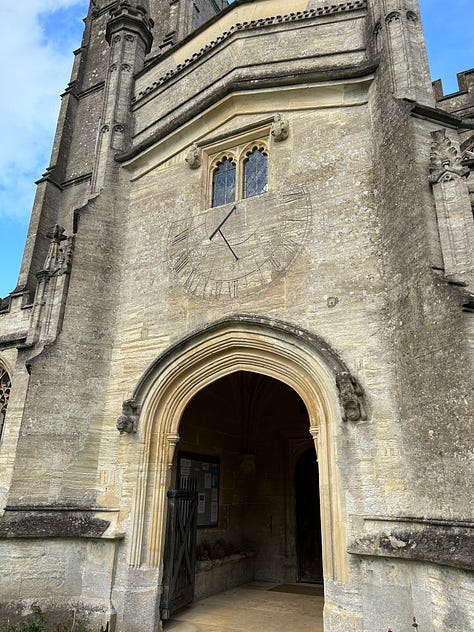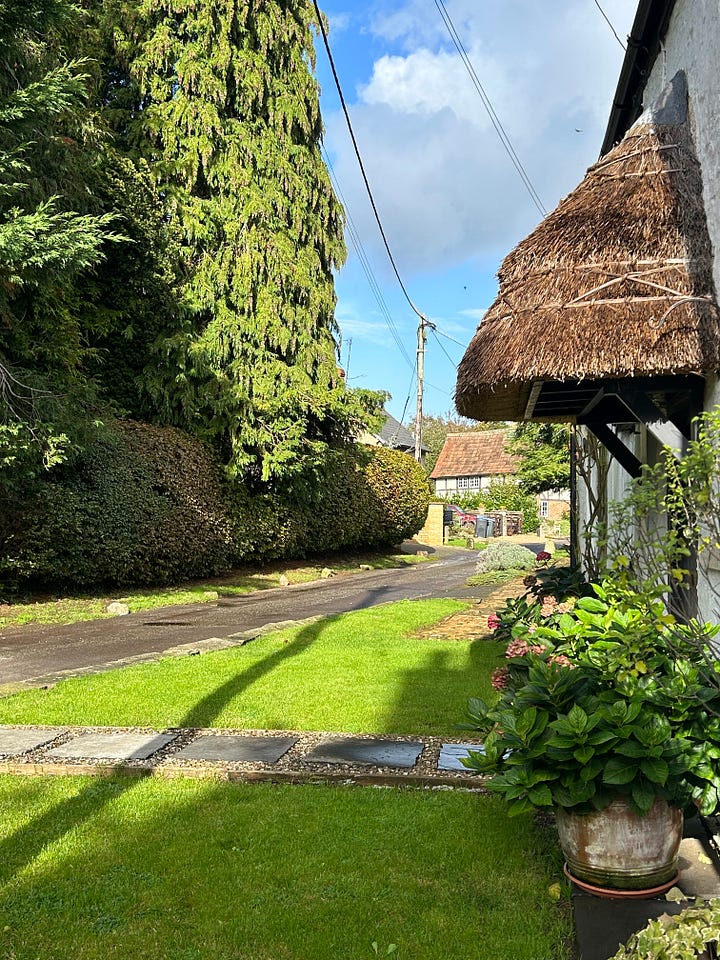Steeple Ashton
a beautiful Wiltshire Village
England has many beautiful villages. Here in the County of Wiltshire, close to where I live is the village of Steeple Ashton. It is packed with charming cottages and other interesting features. The villagers must also be pleased that tourists have not overrun their village. They are drawn to the villages of Lacock and Castle Coombe, leaving Steeple Ashton as a nice quiet place to visit.
This article is free for all subscribers to read in full.
The village takes its name from a time when the church had a steeple; more about that later. The name goes back to Old English stīepel for a steeple, although some have suggested that it should be from stapol, meaning staple, a pole raised to indicate a market. Etymologists dismiss this in the case of Steeple Ashton.
The village was once a market town. It was granted a market charter in 1266. Towns usually start as villages and, for various reasons, have grown over time. It could be that Steeple Ashton is a village today because of an event in the early part of the sixteenth century. A large fire took place, possibly in 1502, and it decimated the cloth industry here. The mill owners relocated to Trowbridge, that has the added advantage of the River Biss flowing through it. The businesses also moved when the workers moved, so the town, industrially and commercially, never recovered.
Let’s take a walk around the village and explore it.
Abandoned Petrol Station
Parking my car, there is one thing I must show you as we enter the village from the direction of Trowbridge. Here, we see the abandoned Dartmoor Garage on Common Hill and the much-photographed petrol pumps. For many years, this was a National Benzole petrol station, and it takes its name from the field upon which it was built. The earliest pump was likely installed in 1930. How long will these remain here before someone wants to develop the site or the rust does its final damage? Time will tell.





The High Street runs through the length of Steeple Ashton, and leaving the garage behind, we move seamlessly from Common Hill onto it. All along the High Street are beautiful cottages, and whilst not knowing their history, it’s worth photographing many of them to add to the galleries in this article. To view any photo in its largest size, click on it.


As we pass the Methodist Church, which is still in use, we see some lovely old cottages alongside it. The chapel was built in 1854 and refurbished in 1991. Along the first part of the High Street is a mixture of old and new. The most modern developments in the village tend to be on the side roads on the westerly side.
Church of St Mary the Virgin
On my left, I reach Church Lane, and as the name of the village originates from the church's steeple, we ought to take a look. But wait… There is no steeple!
The church, built in limestone Ashlar, is a rebuilding in the late 15th century of an earlier church. Records show there was a church in Steeple Ashton in 1252. The tower we see today, which might be from the early 15th century, once had a steeple on top. The steeple was 93 feet (28m) high, and when we add that to the top of the tower, it gives an overall height of 186 feet (57m). In the county of Wiltshire, this tower was only surpassed by the height of Salisbury Cathedral, standing at an incredible 404 feet. What happened to the steeple that lends its name to this village? We need to go back to a stormy day in 1670, in fact, two stormy days. In July of that year, the spire was struck by lightning. It was damaged and repaired. In October, lightning, unlike the saying, did strike twice. This time, the spire fell and damaged the nave and aisles. It was not replaced, and what we see now is the result.
One of my favourite colours for watch faces is blue, and the church clock face has a lovely shade of blue. The clock face is 19th century, but the clock is much earlier. It could be one that was recorded in 1543. The time is very accurate, too, when I compare it to my watch. I spent a short while looking around the graves. Morbid? Not for me. I like to see the names and dates of those who died as they give clues about the history of a place.






We can get quite close to The Manor House from one corner of the churchyard. It was built in 1647 for the Bennett family. In 1799, it was purchased along with its estate by Richard Long from nearby Rood Ashton. It remained in the family until the 1970s.
Leaving the church, I walk along the rest of Church Lane with some fine cottages and the modern village hall. This leads to the junction with The Strand on my left, and Church Lane continues until I reach High Street again. At the end of this section is the war memorial on my right. At this point, we can see the village green, surrounded by a white railing, as we continue along the High Street. On the left, as the green starts, is a black and white cottage named The Old Rose & Crown. As the name might give away, this was once a pub and closed in 1968. Opposite are a couple of houses with a distinct look of being former shops. The windows lead me to that conclusion!



Steeple Ashton Lock-up snd Market Cross
At the far end of the green, there is the lock-up dating from the 18th century. Here, miscreants could be held until an appropriate time to put them before the magistrates. Pre-dating the lock-up is the market cross. This is from 1679 and includes a sundial, and with our typical English weather, it is not always readable, unlike the church clock. Situated on the sides of the square stone above the Tuscan column, we find the cube sundial. Today, the time would be hard to read on a sunny day, as the stonework could do with cleaning.



Across from the green, we find Ashton House, dating back to 1400, still standing proudly with the front door overlooking the green. This side of the street has some really old buildings, as seen in the photographs.

Perhaps the most striking of these is known today as The Old Merchants Hall. Built around 1550, it has been in the past a village shop and post office (closed 1907) — an old postcard from 1907 calls it Ye Olde House. It might have once been made of wattle and daub and brick filled later. It was once three houses before it was converted to one. The current name came in after the conversion to a house and has no bearing on its history.
The Longs Pub



The only pub in the village, The Longs, is set within a 16th-century courthouse, yet another example of the long history of Steeple Ashton.
Just after the pub is another ancient building, Black Barn Cottage, which was built in the 15th century. My walk now takes me past another fine old black and white house, 48 High Street. Above the door is the name The Old Shop. Further along the road is The Old School House, a 15th-century property built originally as the wing of a larger, taller house. It’s a handy location for the current owners as the community village shop is next door.


Steeple Ashton Village Shop
The village shop is run as a co-operative with around seventy volunteers and a full-time employed manager to organise them. It was set up in 2005, and it’s good to see it open as I enjoy my walk around Steeple Ashton. I believe the shop is also set in a building that was once a school.



I soon reach the end of the village, and standing on the corner of Silver Street is this beautiful thatched cottage you can see in the photo below. Hauliers, Geo. T Brown has trucks parked in their yard behind it. This is a business founded in this very lane in 1872. They must be one of the oldest businesses in the county.
Before setting off for home, I backtracked and walked along Dark Lane North to take photos of some lovely old buildings. There is also a Dark Lane South, which has only a few homes, many of which are of more recent construction than those in this lane.




This village has so many fine houses, and I would love to show you all of them! The stories this place could tell would be amazing, and I am looking into a few that I hope to add as an additional part to this article in the coming months. Become a subscriber if you are not already to ensure you don’t miss them!









Your picture of the "Old Berrett Homestead" on the NW corner of Silver St. and High St. was the ancestral home of 5 generations of Berretts from 1730-1864 (134+ years). There are still Berretts living in Steeple Ashton. We have an entire published book with many historical photos and biographies of the lives of all who lived there entitled: Down Berrett Lane - the Steeple Ashton Berretts from1604-1978. (My mother was Lou Jean Berrett) Martin Green martinlgreen@live.com
I lived in Steeple Ashton from the age of 9, and now live in another village a mile away. The school was called St Mary's and I attended. My dad, Michael Green was headteacher. In the 70s there were 3 shops, the Old Merchants Hall, the house near the school on the corner of Acreshort Lane, and one next to Ashton House which was also the Post Office. I was married in St Mary's Church by the Rev. Moore, who the school ( being a Church of England School) had regular visits and events such as Harvest Festival with. The village hall in Church Street was and still is the gathering place for social events including wedding receptions. I have a copy of a photo taken for a completely unknown reason, of all of the villagers ( those who turned out) standing on the village green. This must have been the 90s. The Longs Arms back in the day, was a basic place - dartboard and jukebox, no food, farmers in wellies, and run by a lovely couple called Ray and Daisy Turner. Steeple Ashton is a beautiful village and I am thankful to have grown up there.